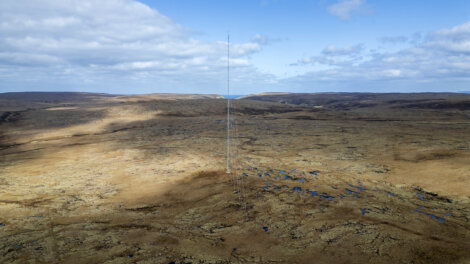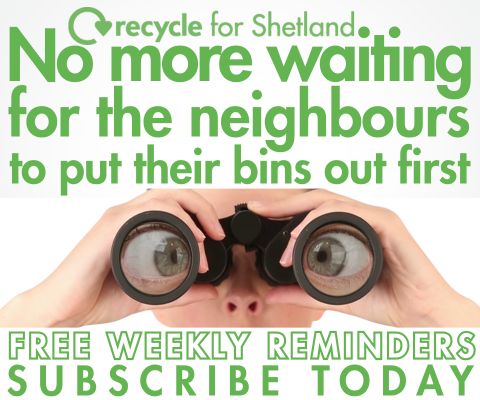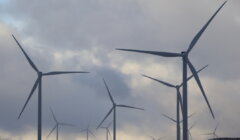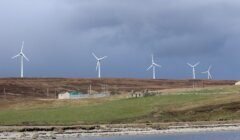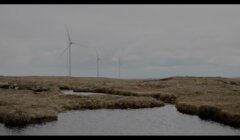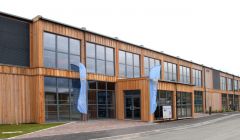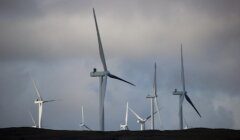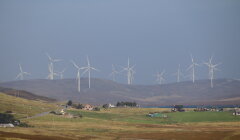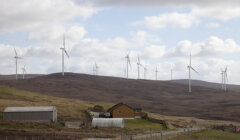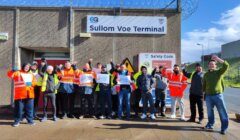Viewpoint / What is happening to Yell?
Yell will see some big changes over coming years with two large onshore wind farms plus associated infrastructure set to be constructed on the island which is also part of the Scottish Government’s carbon neutral islands project. In this long and thorough ViewPoint contribution, local resident Adrian Brockless explores some of the contradictions of the processes involved and wonders if, perhaps, we are all on the brink of making some catastrophic mistakes in the name of climate progress.
Preparatory work has now begun for the construction of the Statkraft/Energy Isles windfarm in North Yell in the form of a weather mast, heralding a new era in the industrialisation of Shetland’s natural heritage in the north isles.
Permission has been granted for two out of three developments in Yell – The Beaw Field Windfarm, The Energy Isles/Statkraft Windfarm and the South Yell 132kv switching station, which is in the final stages of planning. These three developments will be linked by 20km of pylons spread across the island.
The Beaw Field Windfarm[i] – formerly owned by PEEL, but bought by Statkraft in 2023 – was granted consent by the Scottish Government on 30/11/2017 with an extension of operational life from 25 years to 40 years granted on 10/02/2023. It will comprise 17 turbines with a tip height of 145m and produce power equivalent to that used by approximately 60,000 average Scottish households on an annual basis. (Site map p.38[ii])
The Energy Isles/Statkraft Windfarm[iii] is to be built in North Yell and will comprise 18 turbines with a tip height of 180m. It will produce power equivalent to the amount used annually by approximately 157,000 average Scottish homes. It is worth noting that the maximum tip height of the Viking turbines is 155m. (Site map p.1 fig.1[iv])
The South Yell 132kv Switching Station is to be built in Burravoe[v] and is designed to export the power generated by both windfarms from Yell onto the National Grid. It will use Gas Insulated Switchgear (GIS) which requires the use of the (man-made) gas Sulphur hexafluoride (SF6). A combination of subterranean cables and 20km of pylons[vi] will be used on Yell to connect each windfarm to the switching station. It will then be exported to the National Grid and sold back to Shetland.
There is much confusing language surrounding net-zero and what it actually amounts to, so here is a brief outline of terminology that is worth bearing in mind before moving on.
- Net Zero: ‘Net Zero’ means the amount of greenhouse gas emissions we put into the atmosphere and the amount we’re able to take out will add up to zero (it includes all greenhouse gases, not just CO2). Net-zero is achieved in relation to territorial emissions.
- Carbon Neutral: Similar to net-zero, but includes wider definitions of offsetting residual emissions – including emissions avoidance activities. Both net-zero and neutrality involve offsetting in the sense that the amount of GHGs removed from the atmosphere is equal to (or more than) that being emitted by human activity. The Carbon Neutral Islands (CNI) project treats Net Zero and Carbon Neutral as equivalent.
- Territorial Emissions: Territorial emissions are emissions that take place within the geographical area of a country (this includes territorial waters). These are the emissions which are recorded in national statistics (and to which the concept of net-zero is answerable). For example, according to the Department for Energy Security and Net-Zero, UK emissions account for around 1% of the global total, (the UK Government has based this on a range of estimates produced by the UN, the International Energy Agency and the World Resources Institute amongst others). In other words, our territorial emissions account for about 1% of all global Greenhouse Gas (GHG) emissions.
- Residual Carbon is the carbon footprint that remains after all feasible methods for reducing carbon impacts have been reasonably exhausted.
- Embodied Carbon: is the carbon that is produced from the moment of mining or extraction of a material (or its components begins), right through to dismantling, demolition and even re-use. Embodied carbon also includes carbon emissions associated with transport, equipment and energy needed for construction, delivery of goods, any waste during construction, energy etc., and also any subsequent maintenance that might be required. Embodied carbon is not accounted for when measuring territorial emissions (and so is not considered in relation to statistics concerning the achieving of net-zero).
According to the Scottish Government, the Yell developments are associated with the drive towards Scotland achieving net zero by 2045. The recent interim target of achieving 75% of net zero by 2030 has recently been scrapped. The Carbon Neutral Islands project (CNI)[vii] aims for Yell to achieve net zero by 2040.
Each of these developments will have a substantial negative impact on Yell’s natural heritage, because – among other things – they will involve the destruction of peatland habitat in pristine or near natural condition with all the consequences for wildlife that that entails. There are several other potential negative environmental impacts that could potentially be very serious, alongside some issues in carbon accounting in relation to these developments. There are also a number of concerns surrounding how these developments have been considered in relation to the Scottish Government’s National Planning Framework 4.[viii] We will look at each.
Peatland – some background
Healthy functioning peatland is the best land-based carbon sink in the world – better even than the rainforest.
The formation of peatland requires a damp climate retaining a waterlogged soil and hard acidic underlying geology. In Yell, conditions are ideal for peat-forming blanket bog. Many plants find such conditions difficult, but species of Sphagnum (bog) moss are very well adapted for them. The Sphagnum consists of two kinds of cell – living green cells which contain chlorophyl and do the photosynthesis, and hyaline cells. The hyaline cells are much bigger than the living green cells and are used for storing water; they allow the Sphagnum to hold many times its own weight in water and hold the majority of rain where it falls. This explains why you have completely saturated ground halfway up or on tops of hills! – The sphagnum holds vast amounts of rainwater in place. Growth of Sphagnum is slow, and decomposition does not occur at anywhere near the same rate (if at all) as in other habitats, because of the lack of oxygen associated with this saturated habitat. The dead remains of the previous year’s growth thus slowly accumulates below the living layer of Sphagnum at a rate of about 1mm per year. This is peat!
Blanket bog formation began in Shetland about 5000 years ago when the climate was substantially warmer and wetter than today and the policy of neolithic humans to clear areas of much of their woodland resulted in the ecological balance tipping towards peat formation. Today, blanket bog is a rare, vulnerable, highly sensitive habitat with its own ecology and is home to a number of specialist species. Many of these species are globally threatened. Internationally, the UK holds 10-15% of all blanket bog with that in Shetland having a rare oceanic-type ecology, making it even more important.
Correct hydrology is essential for the maintenance of healthy acid bog. Acid bogs should have water tables at or just below the surface in winter and no more than 10cm below the surface in summer. Any modification of this bog structure will affect its water balance and, consequently, its soil structure. If the peat containing dead plant material underneath the surface layer dries out, the bog may slump and crack; this will supress the growth of sphagnum moss and release both methane and carbon dioxide (methane is approximately 25x more efficient as a GHG than carbon dioxide). Indeed, any modification of the bog structure will affect its water balance and, accordingly, its soil structure with negative impacts in terms of GHG emissions and the bog’s associated ecology.
Such negative influences on bog hydrology need to be prevented, which in practice means preventing any unnecessary disturbance to the bog. It also needs to be understood that disturbance to a peat bog can be caused by activities elsewhere – in particular by dust from road building blowing onto otherwise undisturbed bog, pollutants released by concreting and similar, alongside any activities that will influence water-table level. Water-table levels can be influenced from some distance away. The developments on Yell will certainly have such effects and have a terrible effect on Yell’s natural heritage.
Many species of plants and animals depend for their existence on blanket bog, as does the existence of much of the wildlife tourism that Shetland enjoys. The following bird species are all known to nest on either the Beaw Field site or the Energy Isles Windfarm site (or both). The list is not exhaustive, but all noted here are either Annex 1 or Red List species[ix] meaning that there exists the threat of extinction of these species at either a national or global level.
- Arctic Skua
- Curlew
- Whimbrel
- Dunlin
- Golden Plover
- Lapwing
- Red-Throated Diver
- Arctic Tern
- Ringed-Plover
- Merlin
- Skylark
The recent problems that birds have encountered with avian flu means that it is imperative that any further pressures on their populations are removed. Unfortunately, the developments granted permission on Yell do quite the opposite.
Wild birds listed on Schedule 1 of the Wildlife and Countryside Act 1981 are given a higher level of protection. It is an offence (in England, Wales and Scotland) to intentionally or recklessly (a) disturb any wild bird included in Schedule 1 while it is building a nest or is in, or near a nest containing eggs or young; or (b) disturb the dependent young of such a bird.
Unfortunately, this only covers birds during the breeding season. It does not prevent measures to deter birds from returning to their traditional sites in spring. This means that it is perfectly legal to use bird scarers to frighten birds from their breeding sites before the nesting season has begun.
Statkraft have said they plan to employ bird-scarers to prevent birds from nesting in the areas where the turbines are due to be built in order to avoid delays to construction during the breeding season.[x] So much of the avifauna that stands to be negatively impacted is Annex 1 and/or red list. How is this the most ecologically responsible option?
Much emphasis has been put on peatland restoration elsewhere to “offset” the damage caused by these windfarms and associated developments that, on Yell, also include the Burravoe switching station and 20km of pylons to link it to the two windfarms.
The International Union for Conservation of Nature (IUCN) stresses the importance of recognising that peatland restoration cannot bring back all values lost as a result of peatland destruction or degradation, which reinforces the primary importance of peatland in pristine or near-natural condition. Indeed, it is a well-known ecological principle that bog regeneration should never be used or accepted as an excuse for the destruction of pristine peat sites, or the exploitation of others. This is because re-wetting of bogs has recently been recognised (by the IUCN) as controversial for two reasons: 1. Whilst re-wetting reduces CO2 emissions it greatly increases emission of CH4 in the short term before it starts to be reabsorbed[xi]. 2. Re-wetting and restoration in no way guarantees restoration of invertebrate fauna which, in turn, is connected to the recovery (or lack of recovery) of the avifauna. If the food supply is not available to birds, they will not return to breed.[xii]
In any case, if Statkraft are willing to restore damaged peatland elsewhere, why not build the windfarms on that, as opposed to digging up that which is pristine or in near-natural condition? That would make more sense, surely? Imagine if there is, for instance, a broch in the proposed site, could it be demolished if, say, Statkraft added a new building to the museum in Lerwick? (Might offsite restoration not set precedence for other issues?)
The scale of the damage that these developments will cause cannot be overestimated. Only in the last few weeks, further demonstration of the kind of lasting damage caused by the construction of such developments and their associated infrastructure took the form of a peat-slide.[xiii] It is surprising, therefore, that certain local officialdom has claimed that the climate crisis is more serious than the biodiversity crisis. This claim is just silly. The two are interdependent; climate change will have an impact on biodiversity and changing biodiversity will have an impact on climate. As territorial emissions, the UK emits about 1% of global GHGs;[xiv] accordingly, Scotland will only emit a proportion of that 1%, Shetland a proportion of that proportion and Yell only a fraction of that! The sensitivity of the ecology of Yell is such that it will pay a disproportionately heavy price from an ecological point of view (this, essentially, is persecution of a minority group).
In any case, the claim that the climate crisis is more serious than the biodiversity crisis is directly contradicted by the position of the Scottish Government in its Fourth National Planning Framework (NPF4) adopted in February 2023.
In Part 1 (summary of policy 3) of NPF4 it states, “Development proposals for national, major or Environmental Impact Assessment (EIA) development will only be supported where it can be demonstrated that the proposal will conserve, restore and enhance biodiversity, including nature networks, so they are in a demonstrably better state than without intervention.” (p.9) and continues in the opening sentence of policy 1 that, “When considering all development proposals significant weight will be given to the global climate and nature crises.” (p.36).[xv] Given the condition of the peatland and acid bog at the Energy Isles site in north Yell, the idea that an area of pristine peatland and peatland in near natural condition will be in a better condition after it has been industrialised is laughable. Since there are areas of peatland that are already degraded, why not put the windfarms on them instead?
Arguably, there is also public expectation that the planning regulations relating to peat are to protect peat in situ. The proposal of offsite restoration was only added to overcome objections by the Scottish Environment Planning Agency (SEPA). Planning should be based purely on the suitability of the site.
Part d of Policy 3 states, “Any potential adverse impacts, including cumulative impacts, of development proposals on biodiversity, nature networks and the natural environment will be minimised through careful planning and design. This will take into account the need to reverse biodiversity loss, safeguard the ecosystem services that the natural environment provides, and build resilience by enhancing nature networks and maximising the potential for restoration.”
The cumulative impacts of the two windfarm developments reaches further than the construction of each windfarm. There is also the matter of the 20km of pylons required to connect each windfarm to SSEN’s Burravoe switching station, alongside the construction of the switching station itself. Each of these is being treated as a separate project, although in reality the windfarms would be useless without the switching station and pylons (and there would be no need for the switching station and pylons without the windfarms). It is worth bearing in mind that neither the pylons nor the switching station generates any power of their own, so when NPF4 states in policy 11e that, “significant weight will be placed on the contribution of the proposal to renewable energy generation targets and on greenhouse gas emissions reduction targets” one can easily see that NPF4 cannot be used to support these developments because neither development generates anything. Accordingly, NPF4 cannot be used to justify granting permission for the switching station or the 20km of pylons.
In his ministerial forward to NPF4 Tom Arthur MSP, Minister for Public Finance, Planning and Community Wealth, says “I am delighted to publish Scotland’s fourth National Planning Framework. I am proud that, for the first time, we have brought together our long-term spatial strategy with a comprehensive set of national planning policies to form part of the statutory development plan.” There is here an explicit claim of the statutory importance of NPF4. Given that NPF4 cannot be used to justify developments which do not generate power, it would seem that granting permission to both the switching station and pylons raises substantial legal questions. It has certainly not been demonstrated that either the switching station or the pylons will “conserve, restore and enhance biodiversity.” (Policy 3 c)
One can only suspect that choosing to treat such developments as separate projects might be for reasons of political expediency – perhaps to minimise opposition.
Insofar as each development would be useless without the other, it should not be the case that they are treated as separate projects just because they are in different stages of development or planning. Indeed, in NatureScot’s Guidance – Assessing the cumulative landscape and visual impact of onshore wind energy developments it states that, “Occasionally it may be appropriate to include proposals in an assessment which are at earlier stages of development (including at scoping)…However, a degree of pragmatism is required to enable proposals to progress to determination, and to cater for proposals which may not yet be in the public domain”[xvi] Thus, any environmental impact assessment needs to treat the cumulative environmental impact of the industrialisation of Yell as a single project, not divide up each development as a separate project. Unless that is done, NPF4 should not be used to justify developments that do not generate any power.
Thus, there would appear to be statutory issues arising from NPF4 in relation to the switching station development and pylons.
Other concerns
The environmental effects of this industrialisation extend far further than the destruction of peatland and wildlife habitat.
At a progress meeting in Sellafirth in June 2023, a Yell crofter asked Energy Isles/Statkraft representatives about the possibility that Gossawater – the loch immediately adjacent to the developments which supplies Yell homes with mains water – might suffer contamination and what plans were in place to deal with such a possibility. The answer they received was that they should not worry, because a pot of money had been set-aside for just such an emergency. When this answer was queried by asking how that would help if Yell’s drinking water was contaminated, the answer given was that Energy Isles/Statkraft will buy all Yell residents bottled water (you could not make this up!). Other than that, no assurances were given concerning mitigations relating to run-off or other forms of pollution that might enter Gossawater. Given the various pollution issues that have plagued the Viking development and construction of associated infrastructure, this is less than heartening.
Statkraft claims that the Energy Isles site pays back all its carbon within 2 years, so it will be net zero from year 3 to 30. This refers to territorial emissions brought about during construction; it does not account for the majority of either embodied or residual carbon. It is not clear whether the claim includes the GHGs released as a result of destruction of active blanket bog. However, it is known that the Carbon Neutral Islands (CNI) project has conducted its recent audit without including any current (Garth) or future (Beaw and Energy Isles) windfarm developments. CNI elected not to include current (Garth Community Windfarm) or future renewables in their carbon audit, the main justification being that this is to ensure results are consistent at all levels. Simultaneously, Statkraft is on record as saying that the windfarm developments “would mark a major step to turn Yell carbon neutral.”[xvii] The question then becomes, who is right?! It is important to stress that there is no official connection between CNI and any of the renewable developments in Yell. However, given that consent has now been given to the destruction of areas of pristine peatland on the promise of restoration elsewhere, that suggests that a windfarm must achieve net-zero in a defined area. Yell windfarms have been excluded from the carbon audit by CNI, so are we talking Shetland, Scotland or a different set of boundaries?
A difficulty for both CNI and the claim by Statkraft that the Energy Isles site will pay back all its carbon within 2 years comes in the form of the Burravoe switching station which, according to the plans, will use Gas Insulated Switchgear (GIS). This requires the use of the (man-made) gas Sulphur hexafluoride (SF6). Sulphur hexafluoride is 23,500 times more powerful as a greenhouse gas than Carbon dioxide and, once in the atmosphere, will remain there for over 1000 years and cannot be removed (some estimates put it at 3,200 years). Sulphur hexafluoride has the highest global warming potential of any substance and it is acknowledged by the National Grid that leaks of SF6 occur during construction and decommissioning of the switching stations that use it[xviii]. According to energypost.eu[xix], global annual emissions of SF6 are about 8,100 tonnes, which is equivalent to the CO2 emissions of 100 million cars. That is more than the annual sale of cars worldwide. Just 1 kg of SF6 has the equivalent global warming effect of 24 people taking a return flight to New York. In 2019-20, the UK’s distribution network operators recorded an average leakage rate of 0.27%, which equates to 866kg of SF6. This is up from 554kg in 2016/17 and equates to approximately 20,784 people taking a return flight to New York. The electrical company Eaton, suggests that throughout the lifetime of GIS switching stations, leaks of SF6 could be up to 15% of what is used in them.[xx] None of this is included in Stakraft’s estimate, as the switching station is a separate project, so the claim of two years rings hollow when properly considered.
Oddly, SSEN does not mention these facts about SF6 in the information pamphlet distributed to Burravoe residents at their South Yell Switching Station Information event May 2023.[xxi]
Responsibility for monitoring SF6 leaks is entirely self-regulated by the energy companies who install such switchgear. It is also worth pointing out that alternatives are available and that more environmentally friendly options will shortly be coming online.[xxii]
As the switching station is being treated as a separate project, independent of the wind turbine developments and as it does not generate any power, there is nothing in NPF4 to support its development. Given this fact and the fact that it is not possible to properly offset leaks of Sulphur hexafluoride, a holistic Environmental Impact Assessment Report (EIAR) is required that accounts for the cumulative environmental impact of both windfarms, the switching station and the 20km of pylons.
It is also worth noting that SSEN state that putting a switching station in Burravoe “…is more efficient than taking the Energy Isles and Beaw Field connections back separately to Kergord. It will also be available to connect future developments on South Yell.” Presumably, that means further industrialisation is planned after both windfarms, switching station and 20km pylons are built.[xxiii]
Finally, there is increasing evidence that both acute and chronic exposure to operating turbines can cause serious problems within a 2km area of residences[xxiv]. In Dr. Sarah Taylor’s Report on the Health Impacts of Wind Farms Shetland she points out that, “Regardess of whether the perceived impacts of noise from wind farms are physiological or psychological in nature, they are considered to cause adverse health effects through sleep disturbance, reducing the quality of life and as a source of annoyance which sometimes leads to stress related symptoms.” She also recognises that, “A number of countries including Scotland are now setting setback limits of 2km to reduce risks, though these are mostly guidelines for best practice rather than legal requirements.”
The 2km setback limit has not been observed in relation to the Beaw Field site in South Yell (see figure 9.6).[xxv]
So much of this information has been buried within vast documents and what might be termed corporate-speak. I hope by putting as much information as I can in one place (albeit rather a lot!), I have helped inform people about what is going on.
None of this should be read as opposition to renewable energy developments – it is vital that we move away from fossil fuels and clean up our negative environmental footprints more generally. However, it is also vital that we are mindful of our vulnerability to make catastrophic mistakes in the name of progress.
Do you have a view on the issues raised in this opinion piece?
Please feel free to either add to the debate in the comment section below or submit a response by email (letters@shetnews.co.uk) to be considered for publication in our letters section.
Notes:
[i] https://www.energyconsents.scot/ApplicationDetails.aspx?cr=EC00003121
[ii] https://peellandp.co.uk/media/4525/pre-application-consultation-report-part5.pdf
[iii] https://www.energyconsents.scot/ApplicationDetails.aspx?cr=ECU00001844
[iv] https://www.energyisles.co.uk/site/assets/files/1122/eiar_-_non-technical_summary.pdf
[v] https://www.ssen-transmission.co.uk/projects/project-map/shetland-renewable-connections/
[vi] https://www.shetnews.co.uk/2024/02/07/new-overhead-power-lines-planned/
[vii] https://www.gov.scot/publications/carbon-neutral-islands-project-progress-report/
[viii] https://www.gov.scot/publications/national-planning-framework-4/
[ix] https://www.birdspot.co.uk/the-red-list
[xiii] https://www.heraldscotland.com/opinion/24345475.shetland-peat-slide-ominous-warning/
[xviii] https://www.nationalgrid.com/stories/energy-explained/what-is-sf6-sulphur-hexafluoride-explained
[xx] https://www.bbc.co.uk/news/science-environment-49567197
[xxiii] https://www.shetnews.co.uk/2024/02/07/new-overhead-power-lines-planned/
[xxiv] https://docs.wind-watch.org/Health_Impacts_Wind_Farms-NHS_Shetland.pdf






























